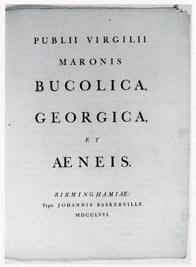Baskerville's Papers
The first specimen of wove paper to appear in the West was used by John Baskerville for printing his famous edition of Virgil in 1757 (the discovery of an earlier example is an eventuality discussed in the Ephemera Section of the book). Only part of the Virgil (28 unmarked sheets) was printed on the new wove paper and the rest on an unusual laid paper. Although Baskerville was satisfied with the quality of the paper, Whatman was not and continued to make experiments to improve it. These steps are described in Chapter I.
It will be noted from the above that, though unmarked, it has been assumed that Whatman was responsible for making the wove paper for the Virgil, and in fact inventing it.
This has been a controversial subject for a very long time. Many scholars thought that Baskerville was a paper maker and was responsible for making this paper. After examining some twenty of Baskerville's printings, only three of which are on wove paper, four of Dryden Leach's, some of the papers bearing Whatman countermarks, a close comparison of the mould marks shows that they were all made by Whatman. The questions of "Motivation" and "Innovation" by the respective protagonists are discussed in Chapter III.
The subject of special papers used by Baskerville in some of his later printings is examined not only in Chapter I but also in Appendix IV.


Title page of Baskerville's Virgil